

Personal Learning Environments Networks and Knowledge. A new Massive Open Online Course #PLENK2010 begins.
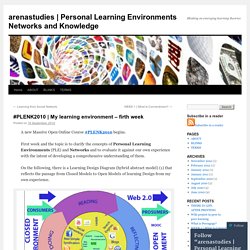
First week and the topic is to clarify the concepts of Personal Learning Environments (PLE) and Networks and to evaluate it against our own experience with the intent of developing a comprehensive understanding of them. On the following, there is a Learning Design Diagram (hybrid abstract model) (1) that reflects the passage from Closed Models to Open Models of learning Design from my own experience. Learning Design Diagram (by @maferarenas) On the diagram above, we can see the changes that remain on Learning Models Design with the emergency of Web 2.0 environment.
Here are the main features: 1. 2. 3. 4. 5. Building Excellence: Exploring the implications of the Curriculum for Excellence for School Buildings. Dr Kenn Fisher Educational Planner Rubida Research New curriculum directions, along with collaborative and team-based pedagogical approaches, now mean that many educators and policy makers are seeing the learning environment as a critical factor in schooling.
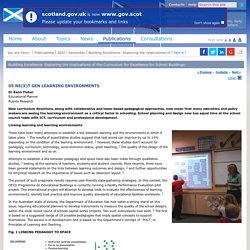
School planning and design now has equal time at the school council table with ICT, curriculum and professional development. Linking learning and learning environments There have been many attempts to establish a link between learning and the environments in which it takes place. 1 The results of quantitative studies suggest that test scores can improve by up to 14% depending on the condition of the learning environment. 2 However, these studies don't account for pedagogy, curriculum, technology, socio-economic status, good teaching, 3 the quality of the design of the learning environment and so on.
The pursuit of such pragmatic results requires user-friendly data-gathering strategies. Fig. 1 LINKING PEDAGOGY TO SPACE Rubida Research. Learning Environment Definition. Learning environment refers to the diverse physical locations, contexts, and cultures in which students learn.
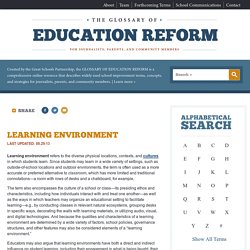
Since students may learn in a wide variety of settings, such as outside-of-school locations and outdoor environments, the term is often used as a more accurate or preferred alternative to classroom, which has more limited and traditional connotations—a room with rows of desks and a chalkboard, for example. The term also encompasses the culture of a school or class—its presiding ethos and characteristics, including how individuals interact with and treat one another—as well as the ways in which teachers may organize an educational setting to facilitate learning—e.g., by conducting classes in relevant natural ecosystems, grouping desks in specific ways, decorating the walls with learning materials, or utilizing audio, visual, and digital technologies.
Learning Environment in the Classroom: Definition, Impact & Importance. Learning Environment. Learning Environment "Learners in supportive environments have high levels of self-efficacy and self-motivation and use learning as a primary transformative force.

"1Welcoming the learner –child, youth or adult– in an environment where they can feel safe and nurtured for is very important for the development of each individual and the society as a whole. Learning environment. Le_white_paper-1.pdf. Learning environment - definition of learning environment by Medical dictionary. Brief%207%20-Performance%20Standard%205%20Learning%20Environment.pdf. Enriched Learning Environments - Definition. ELI3021.pdf. Personal learning environment. Personal Learning Environments (PLE) are systems that help learners take control of and manage their own learning.[1] This includes providing support for learners to: Set their own learning goals.Manage their learning, both content and process.Communicate with others in the process of learning.

A PLE represents the integration of a number of "Web 2.0" technologies like blogs, Wikis, RSS feeds, Twitter, Facebook, etc. around the independent learner. Using the term "e-learning 2.0", Stephen Downes describes the PLE as: "... one node in a web of content, connected to other nodes and content creation services used by other students. It becomes, not an institutional or corporate application, but a personal learning center, where content is reused and remixed according to the student's own needs and interests. It becomes, indeed, not a single application, but a collection of interoperating applications—an environment rather than a system".[2] See More[edit] External links[edit] References[edit] Mcloughlin.pdf. s40561-014-0004-5.pdf. Teach Abroad: Teach English Abroad with Footprints Recruiting. I think that we can all relate to sitting in a class trying not to nod off or listening to an instructor who is brilliant in a particular field but who has no ability to engage students.
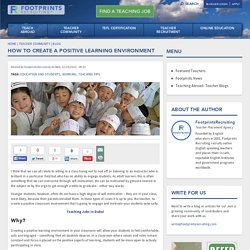
As adult learners this is often something that we can overcome through self-motivation. We can be motivated by genuine interest in the subject or by the urge to get enough credits to graduate – either way works. Younger students, however, often do not have a high degree of self-motivation – they are in your class, most likely, because their parents enrolled them. In these types of cases it is up to you, the teacher, to create a positive classroom environment that is going to engage and motivate your students externally. Teaching Jobs in Dubai Why? Educational Leadership:The Positive Classroom:Seven Strategies for Building Positive Classrooms. Lyons87128_0170187128_02.01_chapter01. Learning Environment. Access keys | Skip to primary navigation | Skip to secondary navigation | Skip to content | Skip to footer | Problems viewing this site.
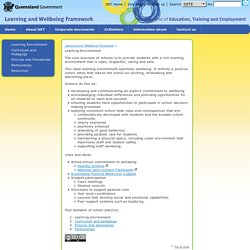
Twenty Tips for Creating a Safe Learning Environment. I visit a lot of classrooms.
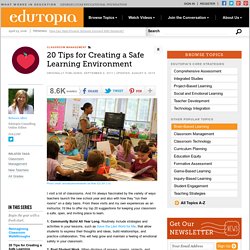
And I'm always fascinated by the variety of ways teachers launch the new school year and also with how they "run their rooms" on a daily basis. From these visits and my own experiences as an instructor, I'd like to offer my top 20 suggestions for keeping your classroom a safe, open, and inviting place to learn. 1. Community Build All Year Long.